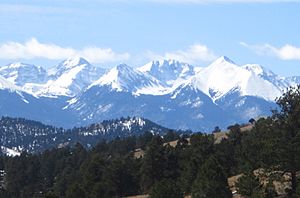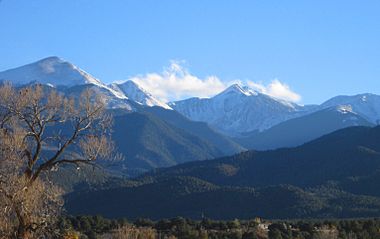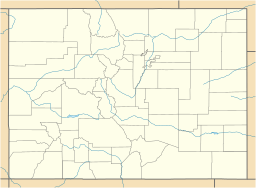Sangre de Cristo Range facts for kids
Quick facts for kids Sangre de Cristo Range |
|
|---|---|
| Northern Sangre de Cristo Mountains | |

Sangre de Cristo Range seen from Hardscrabble Pass.
|
|
| Highest point | |
| Peak | Blanca Peak |
| Elevation | 14,345 ft (4,372 m) |
| Dimensions | |
| Length | 75 mi (121 km) north-south |
| Width | 48 mi (77 km) east-west |
| Area | 1,250 sq mi (3,200 km2) |
| Naming | |
| Etymology | Sangre de Cristo Spanish: Blood of Christ |
| Geography | |
| Country | United States |
| Parent range | Sangre de Cristo Mountains, Rocky Mountains |
| Geology | |
| Orogeny | Fault-block mountains |
| Age of rock | Precambrian and Permian-Pennsylvanian |
The Sangre de Cristo Range is a group of mountains in the Rocky Mountains. It is located in southern Colorado, United States. These mountains stretch from north to south along the eastern side of the Rio Grande Rift.
The range runs for about 75 mi (121 km) (120 km) from Poncha Pass in the north to La Veta Pass in the south. This is about 20 mi (32 km) (32 km) west of Walsenburg. The Sangre de Cristo Range forms a tall ridge. It separates the San Luis Valley on the west from the Arkansas River watershed on the east. The mountains rise over 7,000 ft (2,100 m) (2,100 m) above the valleys and plains nearby.
The USGS says this range is the northern part of the larger Sangre de Cristo Mountains. Those mountains continue into northern New Mexico. This article focuses only on the mountains between Poncha Pass and La Veta Pass in Colorado.
Contents
Tallest Peaks: Sangre de Cristo Mountains
The Sangre de Cristo Range has many high peaks. Some of the most famous are called "fourteeners." These are mountains that are over 14,000 feet (4,267 meters) tall.
| Peak name | Elevation | Prominence |
|---|---|---|
| Blanca Peak | 14,351 ft (4,374 m) | 5,326 ft (1,623 m) |
| Crestone Peak | 14,300 ft (4,400 m) | 4,534 ft (1,382 m) |
| Crestone Needle | 14,197 ft (4,327 m) | 437 ft (133 m) |
| Kit Carson Peak | 14,165 ft (4,317 m) | 1,005 ft (306 m) |
| Challenger Point | 14,080 ft (4,290 m) | 281 ft (86 m) |
| Humboldt Peak | 14,064 ft (4,287 m) | 1,164 ft (355 m) |
| Ellingwood Point | 14,042 ft (4,280 m) | 322 ft (98 m) |
| Mount Lindsey | 14,042 ft (4,280 m) | 1,522 ft (464 m) |
| Little Bear Peak | 14,037 ft (4,278 m) | 357 ft (109 m) |
| Columbia Point | 13,960 ft (4,260 m) | 320 ft (98 m) |
| Mount Adams | 13,937 ft (4,248 m) | 851 ft (259 m) |
| California Peak | 13,855 ft (4,223 m) | 609 ft (186 m) |
| Rito Alto Peak | 13,800 ft (4,200 m) | 1,114 ft (340 m) |
| Colony Baldy | 13,711 ft (4,179 m) | 905 ft (276 m) |
| Pico Aislado | 13,612 ft (4,149 m) | 837 ft (255 m) |
| Tijeras Peak | 13,610 ft (4,150 m) | 724 ft (221 m) |
| Electric Peak | 13,601 ft (4,146 m) | 915 ft (279 m) |
| Cottonwood Peak | 13,504 ft (4,116 m) | 1,108 ft (338 m) |
| Twin Peaks | 13,560 ft (4,130 m) | 600 ft (180 m) |
| Broken Hand Peak | 13,579 ft (4,139 m) | 653 ft (199 m) |
| Fluted Peak | 13,560 ft (4,130 m) | 714 ft (218 m) |
| Milwaukee Peak | 13,528 ft (4,123 m) | 282 ft (86 m) |
The highest peak in the range is Blanca Peak, which is 14,345 ft (4,372 m) (4,372 m) tall. It has three other fourteeners nearby: Little Bear Peak, Mount Lindsey, and Ellingwood Point.
Other well-known peaks include the Crestone group. These are Kit Carson Mountain, Crestone Peak, Crestone Needle, and Humboldt Peak. Two smaller peaks of Kit Carson Mountain are named Challenger Point and Columbia Point. They honor the crews of the Space Shuttle Challenger and the Space Shuttle Columbia.
Exploring the Geography of the Sangre de Cristo Range
The Sangre de Cristo Mountains stretch from Poncha Pass in Colorado down to Glorieta Pass in New Mexico. Most of this mountain range is part of two National Forests. The northeast side, near the Arkansas River, is in the San Isabel National Forest. The southwest side, facing the San Luis Valley, is in the Rio Grande National Forest.
The middle part of the range is a protected area called the Sangre de Cristo Wilderness. This means it is kept wild and natural. The Great Sand Dunes National Park and Preserve is located on the southwest side of the range. It sits right at the edge of the San Luis Valley.
There are no paved roads that cross the main ridge of the mountains. You can only cross it using four-wheel drive vehicles or by hiking on trails. These trails go over passes like Hayden Pass, Hermit Pass, Music Pass, Medano Pass, and Mosca Pass.

History and Economy of the Mountains
In 1719, a Spanish explorer named Antonio Valverde y Cosio saw the mountains at sunrise. The snowy peaks looked reddish, like "Blood of Christ." This is why he named them "Sangre de Cristo." This beautiful sight is called alpenglow.
Today, tourism is the main way people make money in this area. Many visitors come to see the stunning mountains and enjoy outdoor activities.
How the Sangre de Cristo Mountains Were Formed

The Sangre de Cristo Mountains in Colorado are fault-block mountains. This means they were formed when large blocks of the Earth's crust moved up along cracks, or fault lines. They are similar to the Teton Range in Wyoming.
There are major fault lines on both the east and west sides of the range. In some places, these faults even cut through the mountains. Because they are fault-block mountains, the Sangre de Cristos do not have gentle foothills. Instead, the highest peaks rise very steeply from the valleys. In some areas, the mountains go up 7,000 ft (2,100 m) (2,100 m) in just a few miles.
These mountains were pushed up about 5 million years ago as one big piece of rock. The Sangre de Cristo range is still slowly rising today because the faults in the area are still active.
On the west side of the mountains is the San Luis Valley, which is part of the Rio Grande Rift. To the southeast, you'll find the Raton Basin, which is a quiet but still active area with volcanoes. On the northeast side are the Wet Mountains and the Front Range. These areas have very old rocks, formed about 1.7 billion years ago.
The Blanca Massif is made of these very old rocks. However, most of the rest of the Sangre de Cristo mountains are made of younger rocks. These rocks are about 250 million years old. They are a mix of sedimentary rocks like conglomerates and shales, and also igneous rocks. These sedimentary rocks were formed from sediment that was eroded from the Ancestral Rocky Mountains.



